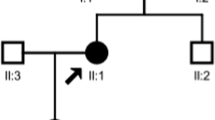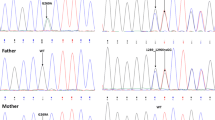Abstract
SLC4A4 variants are the etiologies of inherited proximal renal tubular acidosis (pRTA), which results in metabolic acidosis, hypokalemia, glaucoma, band keratopathy, and cataract. This study aims to characterize SLC4A4 variant and uniparental isodisomy of chromosome 4 in a patient, and analyse the functional characterization of SLC4A4 variants. This study analyzed renal tubular acidosis disease genes by whole exome sequencing (WES). H3M2 algorithm was used to analyze the run of homozygosity region in chromosomal regions in trio-WES data. The pathogenicity analysis of variants was performed using bioinformatics tools. Additionally, protein stability was analyzed by cycloheximide chase assay. Whole-cell patch clamping was used to examine the electrophysiological properties of NBCe1-A. A novel homozygous SLC4A4 variant was identified in the patient: a missense variant c.496C > T, p. Arg166Trp (NM_003759.4). But the father was heterozygous variant carrier, and the mother did not detect the variant. The H3M2 and UPDio algorithm revealed paternal uniparental isodisomy on chromosome 4 in the patient. SIFT, Poly Phen-2, FATHMM and Mutant Taster showed that the variant might be pathogenic. The tertiary structure analysis showed that the variant could cause structural damage to NBCe1 protein. Foldx results showed that the protein stability of the variant was slightly reduced. Cycloheximide chase assay demonstrated that the variant affects protein stability. The result of electrophysiological studies showed that the variant altered Na+/HCO3− cotransport activity of protein. In conclusion, the study is the first to report a pRTA patient with Arg166Trp variant with UPiD (4) pat and analyze the function of Arg166Trp variant.



Similar content being viewed by others
Data Availability
Data from the study can be obtained from the corresponding author.
References
Abuladze N, Song M, Pushkin A, Newman D, Lee I, Nicholas S, Kurtz I (2000) Structural organization of the human NBC1 gene: kNBC1 is transcribed from an alternative promoter in intron 3. Gene 251:109–122. https://doi.org/10.1016/s0378-1119(00)00204-3
Adzhubei IA, Schmidt S, Peshkin L, Ramensky VE, Gerasimova A, Bork P, Kondrashov AS, Sunyaev SR (2010) A method and server for predicting damaging missense mutations. Nat Meth 7:248–249. https://doi.org/10.1038/nmeth0410-248
Choi I (2012) SLC4A transporters. Curr Top Membr 70:77–103. https://doi.org/10.1016/B978-0-12-394316-3.00003-X
Del Gaudio D, Shinawi M, Astbury C, Tayeh MK, Deak KL, Raca G (2020) Diagnostic testing for uniparental disomy: a points to consider statement from the American College of Medical Genetics and Genomics (ACMG). Genet Med 22:1133–1141. https://doi.org/10.1038/s41436-020-0782-9
Demirci FY, Chang MH, Mah TS, Romero MF, Gorin MB (2006) Proximal renal tubular acidosis and ocular pathology: a novel missense mutation in the gene (SLC4A4) for sodium bicarbonate cotransporter protein (NBCe1). Mol vis 12:324–330
Gill HS, Choi KY, Kammili L, Popratiloff A (2015) Rescue of the temperature-sensitive, autosomal-recessive mutation R298S in the sodium-bicarbonate cotransporter NBCe1-A characterized by a weakened dimer and abnormal aggregation. Biochim Biophys Acta 1850:1286–1296. https://doi.org/10.1016/j.bbagen.2015.02.014
González-Pérez A, López-Bigas N (2011) Improving the assessment of the outcome of nonsynonymous SNVs with a consensus deleteriousness score. Condel Am J Hum Genet 88:440–449. https://doi.org/10.1016/j.ajhg.2011.03.004
Hamm LL, Nakhoul N, Hering-Smith KS (2015) Acid-Base Homeostasis. Clin J Am Soc Nephrol 10:2232–2242. https://doi.org/10.2215/CJN.07400715
Haque SK, Ariceta G, Batlle D (2012) Proximal renal tubular acidosis: a not so rare disorder of multiple etiologies. Nephrol Dial Transplant 27:4273–4287. https://doi.org/10.1093/ndt/gfs493
Igarashi T et al (1999) Mutations in SLC4A4 cause permanent isolated proximal renal tubular acidosis with ocular abnormalities. Nat Genet 23:264–266. https://doi.org/10.1038/15440
Igarashi T, Sekine T, Inatomi J, Seki G (2002) Unraveling the molecular pathogenesis of isolated proximal renal tubular acidosis. J Am Soc Nephrol 13:2171–2177. https://doi.org/10.1097/01.asn.0000025281.70901.30
Igarashi T, Sekine T, Watanabe H (2002b) Molecular basis of proximal renal tubular acidosis. J Nephrol 15(Suppl 5):S135-141
King DA, Fitzgerald TW, Miller R, Canham N, Clayton-Smith J, Johnson D, Mansour S, Stewart F, Vasudevan P, Hurles ME (2014) A novel method for detecting uniparental disomy from trio genotypes identifies a significant excess in children with developmental disorders. Genome Res 24:673–687. https://doi.org/10.1101/gr.160465.113
Kurtz I (2014) NBCe1 as a model carrier for understanding the structure-function properties of Na+-coupled SLC4 transporters in health and disease. Pflugers Arch 466:1501–1516. https://doi.org/10.1007/s00424-014-1448-8
Lee HW, Verlander JW, Shull GE, Harris AN, Weiner ID (2022) Acid-base effects of combined renal deletion of NBCe1-A and NBCe1-B. Am J Physiol Renal Physiol 322:F208-f224. https://doi.org/10.1152/ajprenal.00358.2021
Magi A, Giangregorio T, Semeraro R, Carangelo G, Palombo F, Romeo G, Seri M, Pippucci T (2020) AUDACITY: a comprehensive approach for the detection and classification of Runs of Homozygosity in medical and population genomics. Comput Struct Biotechnol J 18:1956–1967. https://doi.org/10.1016/j.csbj.2020.07.003
Magi A et al (2014) H3M2: detection of runs of homozygosity from whole-exome sequencing data. Bioinformatics 30:2852–2859. https://doi.org/10.1093/bioinformatics/btu401
Myers EJ et al (2016) A novel mutant Na(+) /HCO3(-) cotransporter NBCe1 in a case of compound-heterozygous inheritance of proximal renal tubular acidosis. J Physiol 594:6267–6286. https://doi.org/10.1113/JP272252
Pejaver V et al (2020) Inferring the molecular and phenotypic impact of amino acid variants with MutPred2. Nat Commun 11:5918. https://doi.org/10.1038/s41467-020-19669-x
Robinson WP (2000) Mechanisms leading to uniparental disomy and their clinical consequences. BioEssays 22:452–459
Schwarz JM, Cooper DN, Schuelke M, Seelow D (2014) MutationTaster2: mutation prediction for the deep-sequencing age. Nat Meth 11:361–362. https://doi.org/10.1038/nmeth.2890
Suzuki M et al (2008) Functional analysis of a novel missense NBC1 mutation and of other mutations causing proximal renal tubular acidosis. Pflugers Arch 455:583–593. https://doi.org/10.1007/s00424-007-0319-y
Wang H, Huo L, Wang Y, Sun W, Gu W (2021) Usher syndrome type 2A complicated with glycogen storage disease type 3 due to paternal uniparental isodisomy of chromosome 1 in a sporadic patient. Mol Genet Genomic Med 9:e1779. https://doi.org/10.1002/mgg3.1779
Yauy K, de Leeuw N, Yntema HG, Pfundt R, Gilissen C (2020) Accurate detection of clinically relevant uniparental disomy from exome sequencing data. Genet Med 22:803–808. https://doi.org/10.1038/s41436-019-0704-x
Zhu Q, Shao XM, Kao L, Azimov R, Weinstein AM, Newman D, Liu W, Kurtz I (2013) Missense mutation T485S alters NBCe1-A electrogenicity causing proximal renal tubular acidosis. Am J Physiol Cell Physiol 305:C392-405. https://doi.org/10.1152/ajpcell.00044
Funding
This work was supported by the Public Health and Technology Project of Tianjin [Grant number TJWJ2021ZD007], the Program of Tianjin Science and Technology Plan [Grant number 21JCZDJC00390], and the Tianjin Key Medical Discipline (Specialty) Construction Project [Grant number TJYXZDXK-040A].
Author information
Authors and Affiliations
Contributions
WHW, CQC: writing-review & editing, project administration, funding acquisition. XTW, SYZ, FYZ: bioinformatics analysis. YL, WCS, SWH: data curation, methodology, functional analysis, investigation, writing-original draft. MZH, YZ: functional analysis.
Corresponding authors
Ethics declarations
Conflict of interest
The authors declare no conflict of interest.
Ethical Approval
This study obtained informed consent from all participants and was approved by the ethics committee of Tianjin Children's Hospital.
Consent for Publication
The authors affirm that human research participants provided informed consent for publication.
Additional information
Publisher's Note
Springer Nature remains neutral with regard to jurisdictional claims in published maps and institutional affiliations.
Supplementary Information
Below is the link to the electronic supplementary material.
Rights and permissions
Springer Nature or its licensor (e.g. a society or other partner) holds exclusive rights to this article under a publishing agreement with the author(s) or other rightsholder(s); author self-archiving of the accepted manuscript version of this article is solely governed by the terms of such publishing agreement and applicable law.
About this article
Cite this article
Liu, Y., Sheng, W., Hou, S. et al. Functional Characterization of a Novel SLC4A4 Variant and Uniparental Isodisomy in Proximal Renal Tubular Acidosis Patient. Biochem Genet (2023). https://doi.org/10.1007/s10528-023-10554-y
Received:
Accepted:
Published:
DOI: https://doi.org/10.1007/s10528-023-10554-y




